Alexandra Park is a beautiful area with beautiful colonial black and white bungalows, rolling hills and heritage trees. But while many are aware of the heritage buildings of S P Jain School of Global Management’s campus at 10 Hyderabad Road that were built in 1935, (as well as the fact that Alexandra Hospital was opened in 1940 and was the site of a world war 2 massacre), few are aware that there are buildings and terrain features in the vicinity that go back more than 100 years. If you read testimonies about the 1915 mutiny, some intriguing questions will come to mind – for instance in what kind of “pool” near the hospital did Sub-Asst Surgeon Asher Varthun hide from the mutineers in 1915? Where was this hospital located? Where was Normanton Barracks? Where was the parade square in Alexandra Barracks? How does it look like today? Where was the “swamp” that existed in Alexandra Barracks? Does it still exist? The answers may surprise you!
In this post I will take you on a tour of such places, and show you with the help of photos, old maps as well as descriptions/testimonies of the 1915 Singapore Mutiny, the location where significant events of the mutiny occurred and how these places look like today. (Not quite Indiana Jones, but close ! 🙂 ). (Note that I have included references to the quotes I included because fact is more interesting than fiction, and so that you can do your own reading.) Anyway hold on to your hats – and enjoy the tour!
ABOUT THE MUTINY
The mutiny started some time after 3pm on 15 Feb 1915 during the Chinese New Year holiday at the “Quarter Guard”.
It involved about half – about 400 of the 5th Light Infantry who were stationed at Alexandra Barracks (present day Alexandra Park) as well as some from the Malay States Guides who were camped to the south of Alexandra Barracks. The mutineers took ammunition, and then some went along Pasir Panjang Road towards the harbour and city. Another group went to Tanglin Barracks to free the German POWs and tried unsuccessfully to enlist their help. Yet another group of mutineers went to attack the old Alexandra Hospital, and then on to the Normanton Barracks. The mutineers later besieged their Commanding Officer’s (LTC Martin) bungalow at present day 7 Royal Road. However, whatever may have been their goals, the mutineers were defeated and rounded up within a matter of days with the help of men from many nations, including Russians, French, Japanese and the Sultan of Johore (Sultan Ibrahim).
(Note to readers : I suggest you open the maps in separate browser tabs so you can toggle between maps and the narrative without losing your way.)

KEY:
THE FOLLOWING BUILDINGS ARE BUILT OF BRICK, WITH TILED ROOFS:-
2 FO’s QRS, COOK HOUSES AND LATRINES, SYCES QRS & STABLES, ARMOURER’S SHOP, QR MRS STORE, DETENTION RMS, DETENTION RMS (SINGLE), SAA STORE, MACHINE GUN SHED, & ALL DHOBY ESTMT BUILDINGS…
ALL OTHER BUILDINGS ARE BUILT OF BINTANGORE POLES, WOOD & ATTAP ON BRICK PIERS
The above 1910 map (Sht 2) shows the eastern half of Alexandra Barracks, and the old Alexandra Hospital at the top edge.
( Source: The British Library Sht 2 http://www.bl.uk/onlinegallery/onlineex/maps/asia/13665093u2u1916.html )(The British Library website is under maintenance due to a cyber attack. Try this link instead https://web.archive.org/web/20210926045619/https:/www.bl.uk/onlinegallery/onlineex/maps/asia/13665093u2u1916.html)
ZOOMABLE map here:www.bl.uk/onlinegallery/onlineex/maps/asia/zoomify137308.html
Click for google earth here:
http://britishlibrary.georeferencer.com/map/wfNIG1tYJ0refxIwAG4o3w/201311081719-hpeGzW/visualize
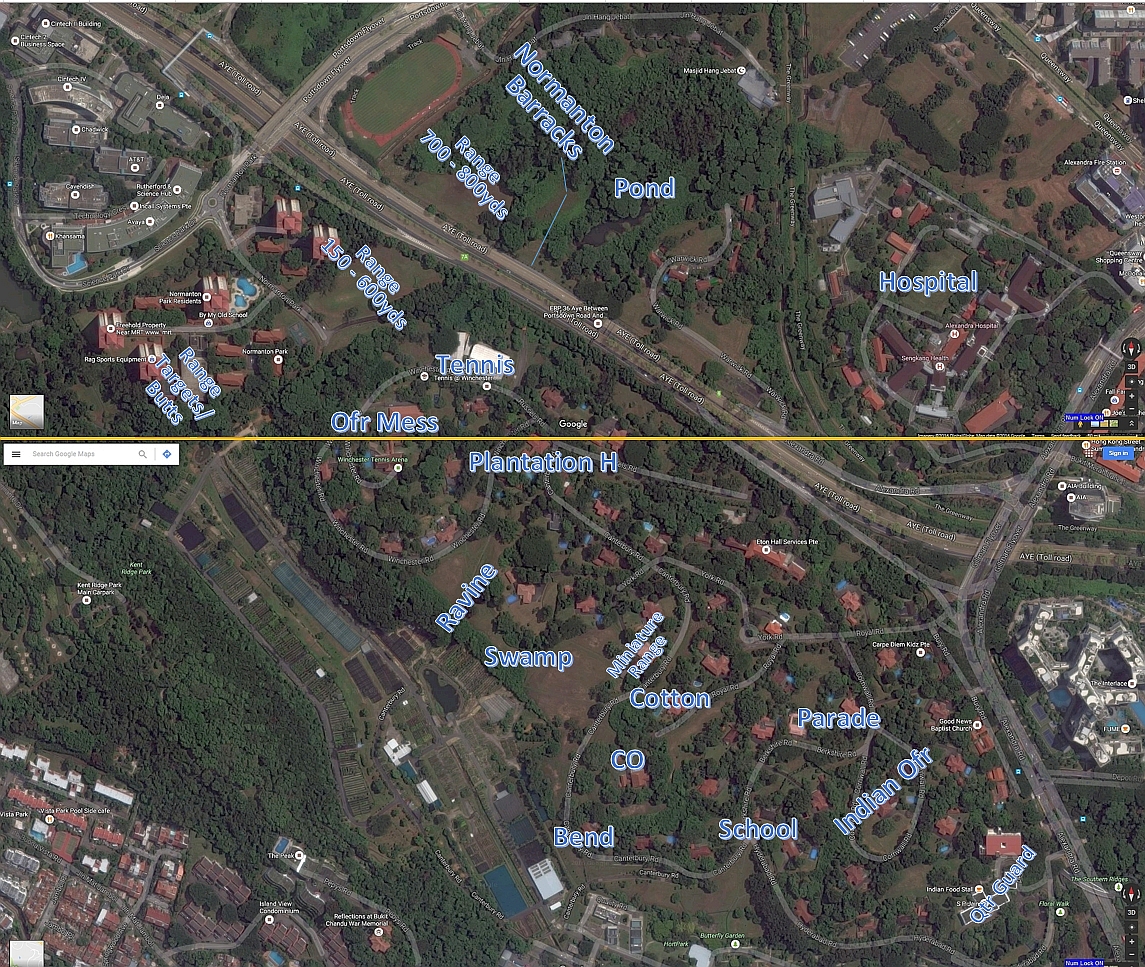
The above shows google map with annotations for the post.
1. THE BEGINNINGS – LOOTING AMMUNITION AT THE “QUARTER GUARD”/”QUARTER GUARD HUT”
The quarter guard was located at the entrance to the camp ie Hyderabad Road next to Alexandra Road.
What was the Quarter Guard ?
“In the Indian Army the quarter guard is the main point of security arrangements for the army camp/garrison Regimental depot. The regimental colours, the armoury and the treasury would be kept in this building. In addition to this the quarter guard also has a lock up often in the guardhouse to hold soldiers charged with minor crimes (absent without leave, drunkenness being among the usual crimes).
…The Armoury is a part of the quarter guard.”

The above is a ZOOMED portion of map Sht 2 showing the Quarter Guard on the right
http://www.bl.uk/onlinegallery/onlineex/maps/asia/zoomify137308.html
The mutineers took ammunition from the magazine (S A A STORE in the map), the quarter guard (perhaps the GUARD AND DETENTION ROOM in the map), as well as from the lorry onto which small arms ammunition was being loaded. This was while it was parked in front of the Quarter Master’s store (QR MRS STORE in the map). (see “Secret documents on Singapore Mutiny 1915 – Dr T R Sareen pg 28 for Report in connection of the mutiny of the Court of Enquiry. Also Testimony of Naik Sazawar Khan, in Sareen pg 55)
Notes :
“ARMOURER SHOP”
According to the armourer in his testimony during the Court of Inquiry, the mutineers told him to go to break open the “treasure chest” (presumably containing money) but he did not do so. (see Sareen pg 114, 73 etc)(pg 717 of “The Quarterly Indian Army List – January 1919, Vol 2 mentions the position of “Treasure Chest Offr” in the Indian Army). Also the Report mentions LTC Martin reply under cross-examination : Q. What about the regimental treasury chests? How many were there and what did they contain? A. There were two chests, a regimental and a private one…$210 in the public chest and $920 in the private chest…The private chest was broken open and $920 was looted. The other had an attack made on it, but it was not a successful one. It was recovered by me with the money intact” (see Sareen pg 609). Interestingly, there is also mention of a chest (see Sareen pg 557) containing “500 rounds of Mark VI, Small Arms Ammunition, in charge of the guard commander. This was kept in an iron safe, the keys of which the guard commander kept. This was ammunition which had come in late the night before and had been given in by detachments relieved from posts. As far as I know, the safe keys were never recovered : the safe was found broken open.”
“FOLLOWER QRS” – what was it?
“FOLLOWER: Indian units had a complement of non-combatants that would follow the unit around the cantonment towns of India and on campaign.”
The Quarter Guard area today (within the grounds of S P Jain campus) :

2. WHERE WAS THE HOSPITAL?
It was located at the present day Alexandra Hospital. (The Office and General Ward blocks were located at the present day Alexandra Hospital sports field.

The above is s ZOOMED view of a portion of 1910 map Sht 2 showing the hospital.
3. POOL OF WATER
“I was hiding in a pool of water with my head under water up to my ears…The pool was half a mile from the hospital, between Normanton Barracks and Tanglin…” – Testimony of Sub-Asst Surgeon Asher Varthun. (Sareen pg 152)

The above 1925 Singapore map shows the old Alexandra Hospital still in existence, and a large area of swampy land (fed by water from Sungei Alexandra) towards the west of it.
If the surgeon had hid in a swampy pond towards the northern end, he would have been roughly between Normanton Barracks and Tanglin.

The swampy pond above is within the swampy area in the 1925 map and is between Normanton Barracks and Alexandra Hospital. Perhaps it was in such a “pool” that Asher Varthun hid.
4. MAJ COTTON’S RETREAT TOWARDS NORMANTON BARRACKS
MAJ Cotton, CPT Ball and CPT Boyce were moving eastwards, pass the Indian officer quarters to investigate when they were fired upon. Remembering that the Malay States Volunteer Rifles (MSVR) were camped at Normanton Barracks (North-West of Alexandra Barracks), they fled towards it to warn the soldiers. However they knew they would likely be shot if they went by the direct route through the vicinity of the parade square, (this was later verified by Mrs Cotton who related that she saw mutineers waiting at the Parade Square area to ambush), so they went in a south-westerly direction and passed the Adult School (Testimony of CPT Ball, Sareen pg 422), then westward along Hyderabad Rd and then present day Canterbury Rd.

The above ZOOMED image from map Sht 2 shows the Parade Square, Indian Officer Quarters, Adult School etc
5. THE PARADE SQUARE
Today there are houses, (eg 1 Cornwall Rd and 1A Berkshire Rd) bushes and trees occupying parts of the site. However the area is still level/flat as one would expect from a parade square.

Parade Square – The above photo was taken from vicinity of junction of Berkshire/Cornwall Road

Parade Square – The above photo shows front lawn of 1 Cornwall Rd

Parade Square – The above photo was taken from behind 1 Cornwall Rd
6. THE ADULT SCHOOL

The above photo is of 7A Hyderabad Road located at/near the site of the Adult School. This does not appear to be the original building. (Do you know why I say this?)
They were shot at from the Indian Officer Quarters until they passed the bend along present day Canterbury Road below/behind the CO’s bungalow. They then went down through the swamp, pass the Officer Mess, the range, and then turned right to Normanton Barracks.

KEY:
THE FOLLOWING BUILDINGS ARE BUILT OF BRICK, WITH TILED ROOFS:-
THE CO’S, 2 MO’S QRS, OFFICERS MESS & QRS, & OUTBUILDINGS
ALL OTHER BUILDINGS ARE BUILT OF BINTANGORE POLES, WOOD & ATTAP ON BRICK PIERS
ALL OTHER BUILDINGS ARE BUILT OF BINTANGORE POLES, WOOD & ATTAP ON BRICK PIERS
The above 1910 map (Sht 1)shows the western half of Alexandra Barracks
http://www.bl.uk/onlinegallery/onlineex/maps/asia/largeimage137306.html
ZOOMABLE map here:
http://www.bl.uk/onlinegallery/onlineex/maps/asia/zoomify137306.html
Click for google earth here:
http://britishlibrary.georeferencer.com/map/HHS81MrhyL5X9osrYbydQf/201311091349-XockPI/visualize
7. THE BEND

The above photo shows a possible point along Canterbury Rd below the CO’s bungalow (7 Royal Rd) after which MAJ Cotton, CPT Ball and CPT Boyce, were shielded by the hill and LTC Martin’s bungalow, from fire originating from the Indian Officer quarters towards the east. (see Sareen pg 403, 422)
8. THE SWAMP
There are many references to the swamp/swampy ground below the CO bungalow/Officer Mess in testimonies/reports of the 1915 Mutiny. eg. Testimony of Naik Abbas Khan : “I got separated…when crossing the marshy ground to the west of the Commanding Officer’s bungalow.” (Sareen pg 177). MAJ Cotton: “We ran along the ridge behind the Indian officers’ quarters and from thence into the swampy ground below the Commanding Officer’s bungalow, thence below the spur on which the Mess House is situated across the range…thence into Normanton Barracks. .” (Sareen pg 386). An example of testimony of the swamp being below the Officer Mess is from CPT Ball (Sareen pg 404)


The above photos shows the swamp (or what remains of it). It is west of CO’s bungalow (7 Royal Rd) and between the CO’s bungalow and the Officer Mess. The ground here today, including parts of the slope is always spongy and water-logged.
9. NORMANTON RANGE
The targets and butts were on the south west side. Traffic along Ayer Rajah Rd would have been much lighter than it is today and so it would presumably have been easy to close the affected section when there was shooting practice.

The above is zoomed image of part of the range from Sht 1.
10. NORMANTON BARRACKS
The barracks consisted of 2 long parallel buildings “20 or 40 yards or 60 apart…bounded on the side nearest to the Alexandra Barracks by a very tall bamboo hedge…a party of the mutineers had come to…bamboo hedge…peered through…decided to leave MSVR alone.” (Testimony of Malcolm Bond Shelley who was a LTA in the Malay States Volunteer Rifles. See Sareen pg 799)

The above is ZOOMED section of 1910 Map Sht 1 showing Normanton Barracks
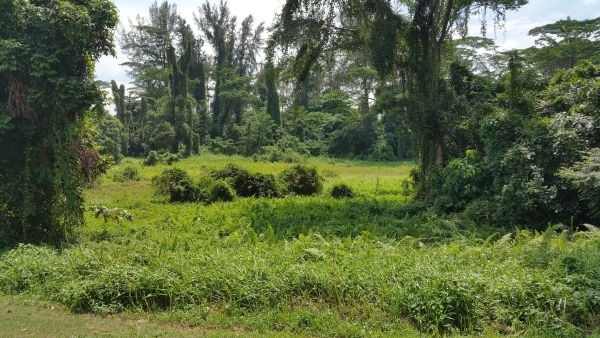
The above photo shows an area beside present day AYE. The track to Normanton Barracks probably went through here, curving towards the left corner. The barracks would have been somewhere between the tree line and the present day Jln Hang Jebat.
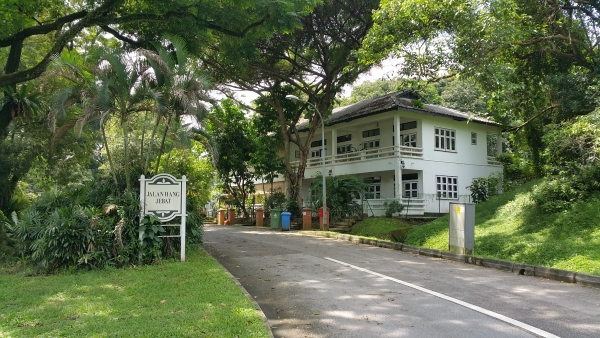
The above photo shows the heritage colonial houses beside Jln Hang Jebat.
Info on the houses by the National Heritage Board can be found here:

The above photo shows one of the flight of steps behind the houses along Jalan Hang Jebat, leading up the slope towards the jungle where Normanton Barracks was earlier located. (It is highly unlikely that there are any remains of the barracks as the buildings were apparently made of wood. Also, in 1942 the Malay Regiment which distinguished itself at the Battle of Pasir Panjang was stationed at Normanton Camp which I presume was at the same site or nearby. As far as I know nothing remains. But who knows ! 🙂 )
11. THE MSVR, NARRATIVE OF THEIR DOINGS IN THE MUTINY
There is an interesting account from the Straits Times of 26April1915 about the MSVR (Malay States Volunteer Rifles), online here:
http://eresources.nlb.gov.sg/newspapers/Digitised/Article/straitstimes19150426-1.2.60.aspx
It describes how CPT Ball, and then MAJ Cotton and CPT Hall came to Normanton Barracks to warn the MSVR, and how they later went to protect the CO’s bungalow.
“83 strong…We fell in and took up positions behind the 700 yds range…and advanced in open order up the hill upon which the officers’ mess stands, opposite to our camp”
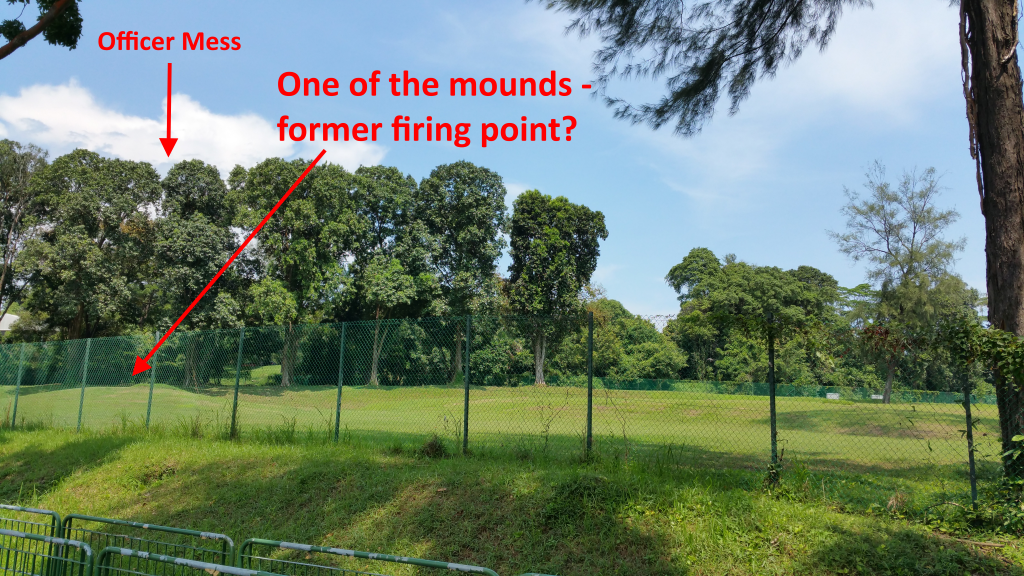
The above photo was taken from AYE towards Normanton Range (present day Normanton Park) and the officer mess on the hill (out of sight). Note that there were Oil Tanks built years later, but not at this portion of the range. Interestingly today there seem to be parallel ridges/mounds here. Are they the remains of man-made firing points from 100 years ago? (Take a walk there and decide for yourself. 🙂 ).
12. TENNIS COURTS

Interestingly, the present tennis courts (above) are located where the tennis courts were in the 1910 map.
13. OFFICER MESS (8 WINCHESTER ROAD)

Photo above of the Officer Mess (8 Winchester Rd)
14. RAVINE AND THE WAY FROM OFFICER MESS TO CO BUNGALOW
“…We had then to descend into a valley and up another hill upon which, COL Martin’s bungalow stands…


The above are photos of the valley, (“Ravine” as marked on the 1910 map sht 1) taken from present day Winchester Road.

The above is another view from below Officer Mess at present day Winchester Road towards CO bungalow on the hill in the distance.
“…and up another hill, upon which COL Martin’s bungalow stands…”
(You will know what was being referred to when you walk between Officer Mess and CO house.)
15. CO’S BUNGALOW (7 ROYAL ROAD)

Above Photo of a heritage Bodhi tree just below the back of CO’s bungalow

Above is ZOOMED section of 1910 map Sht 1 showing CO’s bungalow (7 Royal Rd) with stables at the back (ie on the north-west)

The above photo shows former stables on the right when approaching 7 Royal Road from the back (ie from direction of Officer Mess)

Above photo shows old drain behind 7 Royal Road (CO’s house)
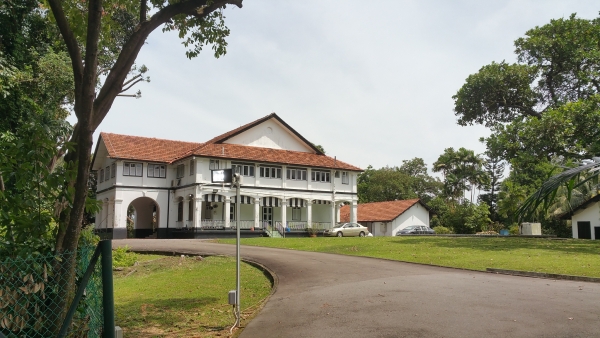
Above is 7 Royal Road (CO LTC Martin’s house) taken from the front entrance with former stables on the right.
During the siege, LTC Martin asked Fort Siloso to use the searchlights to illuminate the area beside his bungalow. (Would you like to know the location of the searchlight at Fort Siloso? So would I and I will try to write another post about this – if time permits.)(Update: read about the latest investigation into this here and earlier investigation here.)

Above photo of heritage tree on south-east of 7 Royal Rd. Behind this tree is a gap in the bushes leading to the other side (back of the house).

Photo above of short cut from front to the back of 7 Royal Rd (behind the heritage tree)
16. MAJ COTTON’S BUNGALOW (6 ROYAL ROAD)

Photo above of 6 Royal Rd, MAJ Cotton’s bungalow (marked as FO’s QRS NO. 1 on 1910 map Sht 1).
The photo shows the gap under the house where Mrs Cotton hid from the mutineers before she was brought to the CO’s bungalow on 15 Feb 1915. Note that the house marked as FO’S QRS NO. 2 was MAJ Stooks’s but no longer exists. Today, 2 York Road stands roughly where MAJ Stooks house was, but it was built years later. Do you know why I say this? Go take a look and decide for yourself !
At the CO’s bungalow on 15 Feb 1915:
“the language on the verandah was delightful…” until Mrs Cotton exclaimed “What dreadful language these men are using.”
Even at the height of the firing, LTC Martin’s Chinese servants were walking about serving tea etc, utterly indifferent to the firing, partly due to their “national stoicism”, and partly because PTE Huxley had assured them that “the whole show was nothing but main main.”
Meanwhile LTC Charles William Brownlow, a veteran army officer in India and now CO of Royal Garrison Artillery, with a hastily assembled mixed force of men from the HMS Cadmus, Royal Artillery personnel and untrained civilians under CPT Edwin Arthur Brown, was tasked with confronting the mutineers.
Brown had brought written instructions to Brownlow to assume a defensive position, but experience told Brownlow that he needed to seize the initiative and proceed towards Alexandra Barracks to break the siege on LTC Martin’s bungalow.
Brown, in his book “Singapore Mutiny” describes how Brownlow reacted to the instruction and arrived at his decision to attack the mutineers :
Brown Pg 125: When I delivered this written document to Brownlow at the corner of Alexandra Road and Pasir Panjang Road, …and after he had read it, he handed the message to me. He gave me a chance to read it again, looked at me, and said “Brown, you have never seen this message, have you?”, and I, feeling that there was something funny about his remark, and guessing what was toward, said promptly “No, Sir.” Brownlow then quietly and deliberately tore up the paper, held it in the flame of the little lamp till it had burnt away, and said, “That is over then, we shall attack from here as soon as it is light enough.”
Brown also describes the untrained state of the civilians under his command as “most of whom had never had a rifle in their hands before, of which they gave ample proof later on…” (Brown pg 46)
“Now Kemp and I were walking in the middle of the road…when there was a “bang” in front of our toes…The thing that made us extra angry was the foolishness of the idiot for pointing his rifle into the middle of the road where we were walking, instead of into the scrub on his right…I am writing this, to say that we were safer with our rifles unloaded than with them ready for action…” (Brown Pg 57). This reminds me of a SAFRA advert a few years ago (prominently pasted in MRT stations) showing a section commander pointing his rifle at the buttocks of one of his men who was lying prone in front of him. The reader will please forgive me for not posting the picture here, thereby embarrassing SAFRA. (However I did post the photo on facebook. 🙂 ). But back to the story.
According to CPT Hall’s testimony (Sareen pg464), Brownlow’s force were advancing towards LTC Martin’s bungalow in “successive lines”, when mutineers fired from the south. Hall then took a megaphone and shouted to the advancing party, “left form!” (pivot towards the left) which they did and drove the mutineers off.
The MSVR narrative also describes how Brownlow’s force drove off the mutineers,”dancing and yelping with delight” as they drove the mutineers “helter skelter like the Gadarene swine down the valley in the front of us…”
The narrative then relates rumours of the plans mutineers had of killing the 5th Light Infantry officers, MSVR officers; as well as men of MSVR as they rested/ate dinner at Normanton Barracks, before going on to Tanglin, Orchard road –
“…Then on to Government House to transfer His Excellency to a better world than this. The whole to wind up with an orgy of murder in Singapore. This intelligence did not sweeten our tempers with our kind friends….”
After the siege was broken, the British retreated to the harbour. It was only the next day that Alexandra and Normanton Barracks were secured.
For those interested in our history/historical places, reports/testimonies about the 1915 mutiny also mention many other places of interest, eg P&O wharves, Tanglin Barracks, Woodneuk, Outram Road Prison, Sepoy Lines, the former Central Police Station along South Bridge Rd, Alexandra police station, Government House, Fort Canning, Orchard Rd police station, the old Drill Hall along Beach Rd, Raffles Hotel, the Padang, Johnston’s Pier, Jardine steps etc. Happy hunting!
(I think the National Heritage Board should consider doing a documentary or series of documentaries about the mutiny in conjunction with the annual Heritage Festival, especially in relation to Alexandra Park. It will add a layer of heritage info and places to visit for locals and tourists alike.)
FINAL NOTES
* PLANTATION HOUSE
MO’S QRS NO. 4, is today 6 Russells Rd. The so called Plantation House.

According to Julian Davison in his book BLACK AND WHITE: THE SINGAPORE HOUSE, 1898-1941, this house was in existence since at least 1905.
Other than this Plantation House, the Officer Mess (8 Winchester Rd), CO’s bungalow (7 Royal Rd) and MAJ Cotton’s bungalow (6 Royal Rd), I don’t know of any buildings that survived from 1910/1915. Do you? 🙂
* DISUSED MINIATURE RANGE BELOW 6 ROYAL ROAD

The above photo taken from present day Canterbury Road shows area where there was a disused miniature range
* SCOUTS
According to the Singapore Scout Association website:
http://scout.sg/history-scouting-singapore
“1915 Scouts rendered service to the Government and the people during the Sepoy Mutiny by taking over from the Army and Police Force duties of telephone operators, dispatch riders and clerks etc.”
* PEOPLE
When reading about the mutiny you will come across many names of people. The following list will help you know who is who:
5th Light Infantry
Lieutenant Colonel Edward Victor Martin (CO)
Major William Lewis Cotton (2IC)
Captain Lionel Romer Ball double company commander
Captain William D Hall double company commander
Captain P Boyce double company commander (killed after he separated from MAJ Cotton and CPT Ball)
Lieutenant H S Elliot company commander (killed)
Lieutenant Wyndham George Strover (Adjutant)(company commander)
Lieutenant E M Malone (Quatermaster)
Lieutenant R V Morrison (Medical Officer)
(The 5th Light Infantry was disbanded in 1922.)
Malay States Volunteer Rifles
Captain Sydney Smith (OC of the detachment)
Malay States Guides
Captain M F A Maclean (Battery Commander) – one of the 1st to be killed by the mutineers
Others
Lieutenant Colonel Charles William Brownlow CO of Royal Garrison Artillery.
Gen Officer Commanding, Singapore Brigadier Gen Dudley Howard Ridout
Governor Straits Settlements Sir Arthur Henderson Young
Singapore Volunteer Corps
Captain Edwin A Brown
Arrived in Singapore in Jan 1901 aged 23 to work for German firm called Brinkmanns. Eventually promoted to Major and awarded the Volunteer Decorations medal. Served 13yrs as Municipal Commissioner, music promoter and was successful businessman. Interned in Changi during WW2. Died 1955. His wife Mary died during internment in Sumatra during WW2. Plaque in St Andrews Cathedral.
More info online about Edwin A Brown:
http://eresources.nlb.gov.sg/infopedia/articles/SIP_1584_2009-10-15.html
Info about Mrs Mary Brown: Film “Paradise Road”. Book: “Women Beyond the Wire” (National library ref: 940.547252095981WAR Central library lvl 11)
INTERESTING READING:
1. Secret documents on Singapore Mutiny 1915 – Dr T R Sareen
(National library ref: 940.41354SAR. Central library 11th Level)
2. Singapore Mutiny – Mary Brown & Edwin Arthur Brown
(National library ref 959.5703BRO)
3. Singapore Mutiny (Published 1984)
R W E Harper & Harry Miller
(National library ref: 355.13340959HAR. Central library 11th Level)
4. Black and white: the Singapore house, 1898-1941. Julian Davison 2006, 2014
(National library ref: 728.37095957DAV)
5. Alexandra Hospital – Jeff Partridge
(National Library ref: 362.11095957PAR Central library 11th Level)
6. World War One In Southeast Asia: Colonialism and Anticolonialism in an Era of Global Conflict – Heather Streets-Salter
(National Library ref: 940.359STR)
On the causes of the mutiny:
Pg 52 ” As imperfect as the final report may have been, it was nevertheless far more balanced than the public explanations offered by the British metropolitan government and the government of Singapore in the immediate aftermath of the mutiny. In fact, the final report from the court of inquiry was never publicly released, which gave British authorities the opportunity to “spin” the event for their own purposes. The public explanation of the mutiny, therefore, was significantly different from the version reconstructed by the court of inquiry.
Hints on visiting Alexandra Park:
How to get there: take Yellow line MRT to Labrador station. Then walk to bus stop along Alexandra Rd outside the ARC. Alight at 2nd bus stop, ie at SP Jain school.
There are toilet facilities and a drinking fountain at Hort Park. (Advise you to carry at least 1.5 litres of water. If you go in the evening please bring insect repellent.)
In Closing:
I do not claim to be a historian or expert in anything, but merely an ordinary person interested in history and historical sites. My purpose of writing about Alexandra Barracks and the 1915 Singapore Sepoy Mutiny is to share with you things I discovered (freely receive, freely give). I hope it will make your “walk in the park” more interesting, and perhaps kindle an interest in Singapore’s heritage. Indeed, sometimes there are interesting stories hidden in plain sight.
Please feel free to share your thoughts, and your own discoveries by writing in the comments section. Thanks and bye for now !
Amazing Walker
Update:
The blog post about the searchlight has been published. Click here to read it :
https://amazingwalks.wordpress.com/2017/02/11/in-search-of-the-1915-fort-siloso-searchlight/
A blog post about Tanglin Barracks and the mutiny has been published here:
https://amazingwalks.wordpress.com/2017/08/09/tanglin-barracks-and-the-singapore-1915-sepoy-mutiny/
Finally solving a 100-year-old mystery ? The second post on the Fort Siloso searchlight has been published :

A really interesting read. I’d never heard of the Sepoy mutiny before this article. Glad I read this. It’ll make my next walk around Hort park so much more exciting!
LikeLike
Thanks Brendan. The mutiny was the only military action in Singapore during world war 1. Your wife and the kids should have no problems tramping across the slopes but your mum and dad would probably have to stick to the roads if they go 🙂
LikeLike
What a good idea to share your walks, Leslie. I look forward to enjoying your discoveries on more amazing walks!
LikeLike
Tks Celina. Unfortunately something went wrong yesterday and the contents of the post cant be displayed. Hope the problem (whatever it is) can be solved soon.
LikeLike
Hi Celina. Yesterday I was able to restore the contents of the post (after I had changed the password to the blog).
LikeLike
Nice place for morning or evening walks set against the backdrop of majestic heritage that is more than a 100 years old. Leslie, thank you for your thorough research and clear writing. I look forward to reading your next informative work.
LikeLiked by 1 person
Read 11 Leaves, an Old House and A Tree. That’s much shorter but also unique/original.
LikeLiked by 1 person
Great article! I live on the disused miniature range!! There are a lot of artefacts from WW2 that can be found in all the gardens around here – such as military buckles, ammunition and old bottles.
LikeLike
Thanks Eira! Glad you like it.
LikeLike
The 5th Light Infantry was reformed and posted to the campaign in German Kamerun, West Africa. It was the only Indian infantry unit in that theatre. It was then sent to the East Africa campaign where it lost many men in hard fighting, including its commanding officer. Finally it was sent to Somaliland where many of the sepoys, already debilitated by exhaustion and disease, succumbed to the harsh climate. In the 1922 Indian Army reforms the regiment was disbanded along with many others. Well done on a fine article
LikeLiked by 1 person
Thank you for your valuable input Major Harry Fecitt.
LikeLike
I just recently shared this on the Alexandra Parks Residents Board. If you would be interested in giving a talk about it at a black and White House, I’m sure they’d be a lot of interest. Please let me know!
LikeLike
please contact me on eiraroseday@gmail.com
thanks x
LikeLike
Hi Eira. Thank you for your suggestion. I have emailed you. 😊
LikeLike
Hi, I run a small tours business specialising in history & heritage and regularly talk about the Sepoy Mutiny as we walk around Alexandra Park, Dempsey Road etc. Would love to connect with you. thx Jane (www.janestours.sg/ jane@janestours.sg/ 86868207. )
LikeLike
Hi Jane! I have emailed you. 🙂
LikeLike
Thx! Have replied to your email… Jane
LikeLike